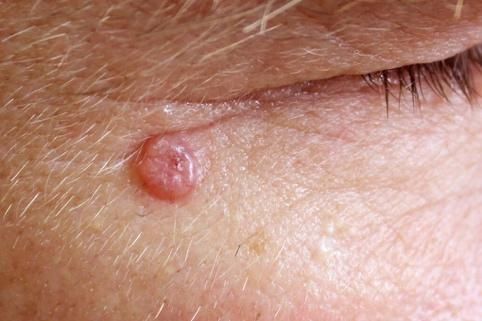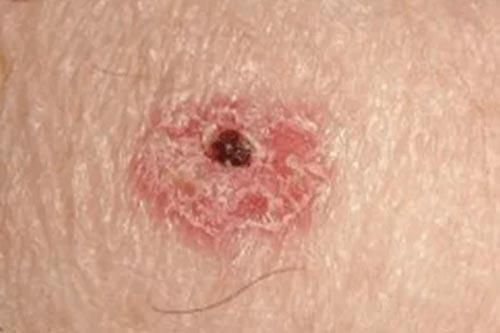Non-Melanoma Skin Cancer Treatment: Basal Cell Carcinoma and Squamous Cell Carcinoma
Explore advanced treatment options for basal cell and squamous cell skin cancer with Dr James Wilson in London. Get personalised, expert-led care for non-melanoma skin cancer.


Jump to:
- What does skin cancer look like? What are the symptoms of skin cancer?
- Basal Cell Carcinoma Treatment
- What is the Most Common Treatment for Basal Cell Carcinoma?
- Treatment Options for Basal Cell Carcinoma
- Radiotherapy for Basal Cell Carcinoma
- Rhenium-SCT for Superficial Basal Cell Carcinoma
- Topical Treatments
- Chemotherapy Cream for Skin Cancer
- Squamous Cell Carcinoma Treatment
- What is the Best Treatment for Squamous Cell Carcinoma?
- Radiotherapy for Squamous Cell Carcinoma
- Why Choose Radiotherapy for Non-Melanoma Skin Cancer?
- Advanced Treatment Options for Non-Melanoma Skin Cancer
- External Beam Radiotherapy (EBRT)
- Rhenium-SCT (Skin Cancer Therapy)
- Treatment for Advanced Cases
- What to Expect During Radiotherapy for Skin Cancer
- Side Effects of Radiotherapy for Skin Cancer
- Early Effects (During and Just After Treatment)
- Late Effects (Months to Years After Treatment)
- Merkel Cell Carcinoma Treatment
- Photodynamic Therapy for Skin Cancer
- Clinical Trials for Skin Cancer
- Patient Experiences with Non-Surgical Skin Cancer Treatment
- Frequently Asked Questions About Non-Melanoma Skin Cancer Treatment
- What is the most effective treatment for basal cell carcinoma?
- How many radiation treatments for basal cell carcinoma will I need?
- What is the best treatment for squamous cell carcinoma?
- Is radiotherapy as effective as surgery for skin cancer?
- What happens after treatment for non-melanoma skin cancer?
- Why Choose Dr. James Wilson for Non-Melanoma Skin Cancer Treatment
- Take the Next Step in Your Skin Cancer Treatment Journey
Not all skin cancers are melanoma, in fact, the commonest form of skin cancer is basal cell carcinoma skin cancer. I also treat squamous cell carcinoma, which is a skin cancer that can affect places such as the lips, the back of the hands, and even the genitalia. Basal cell carcinoma and squamous cell carcinoma are forms of nonmelanoma skin cancer (aka NMSC).
Because non melanoma skin cancer often appears in cosmetically sensitive areas of the face, it's essential that you know all your treatment options before making a decision. The impact on your appearance, along with treatment success rates, should be carefully considered.
What does skin cancer look like? What are the symptoms of skin cancer?
Basal cell carcinomas and squamous cell carcinomas have different appearances, but it’s important to have a biopsy to confirm the diagnosis as there can be a crossover in appearances of the two.

Basal cell carcinomas classically look like a smooth growth with a raised edge and a dent or a dimple in the middle. Or they can appear as a waxy looking lump or a red patch. Sometimes they can be white/pale/yellow scar-like area.

Squamous cell cancers usually appear as scaly red patches or hard crusty lesions. Sometimes they can be wart like lumps or sores that bleed easily do not heal. If you have a skin lesion like this and you notice a lump in a lymph gland, such as a lymph gland in your neck, it’s important to seek medical attention as soon as possible.
I’m often asked if skin cancer is painful. Skin cancers are not usually painful. The most common symptoms are of a change in appearance of the skin or itching. If the skin cancer grows very rapidly or ulcerates, then it could cause local pain or tenderness.
Risk factors for non-melanoma skin cancer: The main risk factor for non-melanoma skin cancer is long-term exposure to ultraviolet (UV) radiation, either from the sun or from sunbeds. People with fair skin, light-coloured eyes, and red or blonde hair are at higher risk, especially if they have a history of sunburn, particularly in childhood. Other risk factors include a weakened immune system, previous radiotherapy treatment, and a personal or family history of skin cancer.
Basal Cell Carcinoma Treatment
Basal cell carcinoma (aka basal cell skin cancer) treatment options have advanced significantly in recent years. As the most common type of skin cancer, basal cell carcinoma (BCC) accounts for approximately 80% of all skin cancer cases. It starts in the basal cells found in the deepest layer of the epidermis.
Treatment for basal cell carcinoma should be sought as soon as possible after the lesion appears. Early detection and prompt treatment of basal cell carcinoma offers the best chance of cure while minimising impact on your appearance.
What is the Most Common Treatment for Basal Cell Carcinoma?
The most common treatment for basal cell carcinoma is surgery. However, radiotherapy plays an important role in skin cancer basal cell carcinoma treatment—particularly in cosmetically sensitive areas such as the face, nose, and ears.
For basal cell carcinoma on face, basal cell carcinoma nose treatment, or basal cell carcinoma near eye treatment, non-surgical approaches often provide excellent cosmetic outcomes while maintaining high cure rates.
Treatment Options for Basal Cell Carcinoma
Treatment of basal cell carcinoma depends on several factors:
-
Size and location of the tumour
-
Whether it's a new or recurrent cancer
-
Your general health
-
Cosmetic considerations
Basal cell carcinoma treatments include:
Radiotherapy for Basal Cell Carcinoma
Radiation treatment for basal cell carcinoma is a highly effective non-surgical option. Basal cell carcinoma radiation treatment is particularly valuable when: The tumour is in a cosmetically sensitive area Surgery might compromise function of nearby structures You wish to avoid surgical scarring Your general health makes surgery high-risk
Is radiation a good treatment for basal cell carcinoma? For many patients, particularly those with basal cell carcinoma on facial areas, radiation offers excellent outcomes without the tissue removal required by surgery.
How many radiation treatments for basal cell carcinoma will you need? Typically, treatment consists of 5-10 sessions delivered over 1-2 weeks, though this varies based on your individual case.
Rhenium-SCT for Superficial Basal Cell Carcinoma
For superficial basal cell carcinoma treatment, I offer Rhenium-SCT (Skin Cancer Therapy)—an innovative treatment that requires just a single visit. This topical radiotherapy treatment involves applying a radioactive paste to the affected area for a short period, typically about an hour.
Rhenium-SCT is particularly suitable for nodular basal cell carcinoma treatment and superficial basal cell carcinoma that hasn't spread deeply into the skin. This treatment boasts impressive response rates of 97.5% at 12 months with excellent cosmetic outcomes. A key advantage of Rhenium-SCT is convenience. Treatment is given in one treatment visit.
Topical Treatments
Basal cell carcinoma treatment cream options include imiquimod, which stimulates the immune system to attack cancer cells. Basal cell carcinoma cream treatment is most effective for superficial BCCs and may be recommended for:
-
Early stage basal cell carcinoma treatment
-
Multiple small lesions
-
Patients who prefer non-invasive approaches
Chemotherapy Cream for Skin Cancer
Chemotherapy cream for skin cancer offers a non-invasive treatment option. It's specifically designed for superficial basal cell carcinomas only. The most commonly used treatment is Efudix (5-fluorouracil). This topical medication works by interfering with DNA synthesis of rapidly dividing cancer cells. It prevents them from growing and multiplying.
This chemotherapy cream for basal cell carcinoma works best for multiple superficial lesions. It's also ideal when surgery might create cosmetic challenges. When applying chemotherapy cream to the face or other visible areas, patients can expect excellent cosmetic outcomes after healing.
It's important to understand the chemotherapy cream side effects before starting treatment. During application, the treated area typically becomes red and inflamed. It often becomes crusty as the medication attacks abnormal cells. These side effects of chemotherapy cream for skin cancer actually indicate the treatment is working properly.
The treatment course usually lasts 3-4 weeks. Full healing typically occurs within 1-2 months afterwards. Skin cancer chemotherapy cream is not suitable for all types of skin cancer. It works specifically for superficial BCCs and some precancerous conditions. It cannot treat deeper growths or other skin cancer types.
I carefully assess each patient's specific condition. This helps determine whether topical chemotherapy cream for skin cancer is appropriate. Sometimes other treatment options might be more suitable.
Squamous Cell Carcinoma Treatment
Squamous cell carcinoma (aka squamous cell skin cancer) treatment requires prompt attention as these cancers can grow more rapidly than BCCs and have a higher potential to spread to other parts of the body.
Treatment for squamous cell carcinoma is guided by the size, location, and aggressiveness of the tumour. Squamous cell carcinoma of the skin treatment often involves similar approaches to BCC but may require more extensive assessment before treatment begins.
What is the Best Treatment for Squamous Cell Carcinoma?
What is the most common treatment for squamous cell carcinoma? Like BCC, surgery is the most frequently used approach. However, for squamous cell carcinoma on face treatment or squamous cell carcinoma lip treatment, radiotherapy often produces superior cosmetic results.
Treatment of squamous cell carcinoma through non-surgical means has advanced significantly. The best treatment for squamous cell carcinoma depends on your individual case, but radiotherapy offers excellent cure rates while preserving appearance and function.
Radiotherapy for Squamous Cell Carcinoma
Radiation treatment for squamous cell carcinoma is particularly effective for:
-
Tumours in difficult-to-operate locations
-
Squamous cell carcinoma scalp treatment
-
Cases where surgery might compromise function
-
Elderly patients who may not tolerate surgery well
External beam radiotherapy (EBRT) delivers precisely targeted radiation to destroy cancer cells while minimising damage to surrounding healthy tissue. For early squamous cell carcinoma treatment, radiation therapy offers cure rates comparable to surgery with excellent cosmetic outcomes.
Why Choose Radiotherapy for Non-Melanoma Skin Cancer?
Radiotherapy provides several advantages over surgery for treating both basal cell carcinoma and squamous cell carcinoma:
-
Non-invasive Treatment: Radiotherapy is completely non-invasive—no incisions, no injections, no tissue removal. This makes it ideal for patients who prefer to avoid surgical procedures or have conditions that make surgery high-risk.
-
Preservation of Appearance: Treatment for basal cell carcinoma on nose UK and other visible areas often produces better cosmetic results with radiotherapy. The gradual healing process allows for natural-looking skin regeneration without surgical scars.
-
Functional Preservation: For basal cell carcinoma eyelid treatment or squamous cell carcinoma lip treatment, preserving the function of these structures is crucial. Radiation can target the cancer while protecting the delicate functionality of these areas.
-
Effectiveness for Difficult Cases: Radiation treatment is particularly valuable for recurrent basal cell carcinoma treatment or when dealing with infiltrative basal cell carcinoma treatment, where surgery might not remove all cancer cells.
Advanced Treatment Options for Non-Melanoma Skin Cancer
External Beam Radiotherapy (EBRT)
External beam radiotherapy represents the gold standard in radiation treatment for skin cancers. The benefits include:
-
Precisely targeted treatment
-
Carefully calculated radiation doses
-
Minimal impact on surrounding healthy tissue
-
Excellent cosmetic outcomes
-
High cure rates for properly selected cases
For both basal cell carcinoma bcc treatment and squamous cell carcinomas treatment, modern EBRT delivers optimal results through sophisticated planning and delivery techniques.
Rhenium-SCT (Skin Cancer Therapy)
This innovative approach to basal cell carcinoma treatment UK and squamous cell carcinoma treatment UK offers:
-
Single-visit treatment
-
No surgery required
-
Excellent cosmetic results
-
High response rates
-
Minimal discomfort
Rhenium-SCT involves applying a radioactive paste to the affected area. This paste delivers targeted radiation directly to the cancer cells without penetrating deeply into healthy tissue. After treatment, there is no residual radioactivity, and you can leave the hospital immediately.
Treatment for Advanced Cases
For metastatic squamous cell carcinoma treatment or advanced basal cell carcinoma treatment, I offer:
-
Immunotherapy
-
Targeted therapy
-
Combination approaches
These treatments are particularly valuable when surgery or radiotherapy alone cannot address the extent of the disease.
What to Expect During Radiotherapy for Skin Cancer
When you choose radiotherapy for basal cell carcinoma treatment or squamous cell carcinoma treatment:
-
Planning Session: We'll meet in the radiotherapy department where I'll examine your skin cancer under magnification and precisely define the treatment area. The team will ensure you're comfortably positioned and may create custom immobilisation devices if needed.
-
Treatment Schedule: Most patients receive between 5-10 treatments over 1-2 weeks, though this varies based on individual factors. Each session typically takes less than 30 minutes.
-
During Treatment: The procedure is completely painless. You'll lie still while the machine delivers precisely targeted radiation to the affected area.
-
After Treatment: You can resume normal activities immediately. Most patients experience minimal disruption to their daily routines throughout the treatment course.
Side Effects of Radiotherapy for Skin Cancer
Radiotherapy side effects typically fall into two categories:
Early Effects (During and Just After Treatment)
-
Skin redness and soreness (appearing after 1-2 weeks)
-
Possible scabbing as healing progresses
-
Mild tiredness
-
Temporary hair loss if treatment area includes hair-bearing skin
Late Effects (Months to Years After Treatment)
-
Slight changes in skin pigmentation or texture
-
Possible tiny visible blood vessels beneath the skin surface
-
Very small risk of radiation-induced cancer (typically 3-5:1000 over 10-15 years)
For most patients receiving basal cell carcinoma treatment or squamous cell carcinoma treatment, these effects are minimal compared to the benefits of successful cancer treatment.
Merkel Cell Carcinoma Treatment
Merkel cell carcinoma is a rare but highly aggressive form of skin cancer that requires prompt expert treatment. How rare is merkel cell carcinoma? It affects approximately 1,500 people annually in the UK, making it much less common than other skin cancers. However, its seriousness cannot be overstated. The treatment approach differs significantly between localised and metastatic disease. For localised merkel cell carcinoma, I typically recommend surgical removal followed by radiotherapy to reduce recurrence risk. This combined approach has proven highly effective for early-stage disease. Can merkel cell carcinoma be cured? With appropriate treatment of localised disease, many patients achieve excellent outcomes. For advanced merkel cell carcinoma, immunotherapy has revolutionised care. Avelumab for merkel cell carcinoma has shown impressive results in clinical studies. The treatment works well for patients who have never received treatment before and for those whose cancer has returned after chemotherapy. Research indicates that up to 73% of patients respond to avelumab treatment. Even more encouragingly, some patients maintain these responses for extended periods, with median survival reaching up to three years in certain studies. How long can someone live with merkel cell carcinoma? These newer treatments have significantly improved life expectancy for many patients. If you've noticed a rapidly growing, painless red or purple nodule, particularly on sun-exposed areas, seek immediate assessment. Merkel cell carcinoma often grows quickly and can spread rapidly to other parts of the body if left untreated. I offer comprehensive treatment planning tailored to each patient's specific presentation, whether newly diagnosed or dealing with recurrent disease.
Photodynamic Therapy for Skin Cancer
Photodynamic therapy (PDT) offers an effective non-surgical treatment option for certain skin cancers, particularly superficial basal cell carcinomas. What is photodynamic therapy? It's an innovative procedure that combines a light-sensitive medication (photosensitiser) with a specific wavelength of light to destroy cancer cells. How does photodynamic therapy work for skin cancer? The photosensitiser is applied to the skin as a cream, where it's selectively absorbed by cancer cells. When activated by light, it triggers a reaction that destroys these abnormal cells while largely sparing surrounding healthy tissue.
Photodynamic therapy UK specialists often recommend this approach for multiple superficial lesions or for cancers in cosmetically sensitive areas like the face. The advantages of photodynamic therapy include excellent cosmetic outcomes, the ability to treat multiple lesions simultaneously, and minimal damage to surrounding tissues. Is photodynamic therapy painful? Most patients experience some stinging or burning during light activation, but this is typically manageable with cooling measures. After treatment, the area may remain sensitive to light for 24-48 hours. Photodynamic therapy cost UK patients should expect varies based on the treatment area size and number of sessions required, but many find it cost-effective compared to surgical options, particularly for multiple lesions. While it's not suitable for all skin cancers, PDT provides an important option in our treatment arsenal, especially for patients who wish to avoid surgery or have cancers in difficult-to-treat locations.
Clinical Trials for Skin Cancer
I actively participate in clinical trials investigating new treatments for skin cancer. These research studies help advance our understanding and improve future care options. Cancer Research UK sponsors many important skin cancer trials across the country. Their work has led to significant breakthroughs in treatment approaches. Patients who join clinical trials often gain access to innovative therapies before they become widely available. Additionally, they contribute valuable knowledge that benefits future patients. I can discuss whether any current trials might be suitable for your specific situation. The field of skin cancer treatment continues to evolve rapidly through research. New targeted therapies and immunotherapy approaches show particular promise. Working alongside organisations like Cancer Research UK allows us to transform today's research into tomorrow's standard treatments.
Patient Experiences with Non-Surgical Skin Cancer Treatment
"Dr Wilson is an excellent clinician - above and beyond in his explanations of issues. Kind and compassionate. His relaxed confident manner puts his patients at ease. I felt I was in safe hands throughout my course of radiotherapy and aftercare." — Doctify review "We are extremely grateful to have been under the guidance and supervision of Dr Wilson during this difficult period however his professional approach and care were always at the forefront and we as a family thank him for his service and support. A credit to his profession." — Doctify review
Frequently Asked Questions About Non-Melanoma Skin Cancer Treatment
What is the most effective treatment for basal cell carcinoma?
The most effective treatment for basal cell carcinoma depends on the specific characteristics of your cancer. For many patients, radiotherapy offers cure rates comparable to surgery with excellent cosmetic outcomes, particularly for facial lesions. Your treatment will be personalised based on the location, size, and type of your BCC.
How many radiation treatments for basal cell carcinoma will I need?
Most patients receive 5-10 radiation treatments over 1-2 weeks. The exact number depends on factors including the size and location of your tumour, your general health, and the specific radiotherapy technique used. I'll create a personalised treatment plan that balances effective cancer control with minimal side effects.
What is the best treatment for squamous cell carcinoma?
The best treatment for squamous cell carcinoma is determined by several factors including the tumour's size, location, depth, and aggressiveness. While surgery is common, radiotherapy offers excellent outcomes for many patients, particularly for facial lesions where cosmetic results are important. For some cases, a combination of treatments may provide optimal results.
Is radiotherapy as effective as surgery for skin cancer?
For properly selected cases of basal cell carcinoma and cutaneous squamous cell carcinoma, radiotherapy offers cure rates comparable to surgery. It's particularly valuable for tumours in cosmetically sensitive areas or locations where surgery might compromise function. The non-invasive nature of radiotherapy also makes it an excellent option for patients who wish to avoid surgical procedures.
What happens after treatment for non-melanoma skin cancer?
After completing treatment, you'll have regular follow-up appointments to monitor healing and ensure the cancer remains controlled. The treated area will gradually heal over 4-6 weeks. Long-term, you'll need to be vigilant about sun protection, as treated skin is more sensitive to UV radiation. I'll provide comprehensive guidance on post-treatment care and monitoring.
Why Choose Dr. James Wilson for Non-Melanoma Skin Cancer Treatment
As a leading Clinical Oncologist specialising in non-melanoma skin cancer treatment, I offer:
-
Expertise in cutting-edge radiotherapy techniques
-
Access to innovative treatments including Rhenium-SCT
-
A comprehensive, personalised approach to your care
-
Focus on both cancer control and cosmetic outcomes
-
Rapid access to consultations, tests and treatments
-
Continuity of care throughout your entire treatment journey
At every appointment, you'll see me personally, not a doctor-in-training. I ensure all your questions are answered and share my treatment letters and reports with you on the same day as your appointment.
Take the Next Step in Your Skin Cancer Treatment Journey
Contact us today to discuss your skin cancer diagnosis and explore advanced treatment options tailored to you.
If you've been diagnosed with basal cell carcinoma or squamous cell carcinoma, prompt treatment can provide the best chance of cure with minimal impact on your appearance. Let me put my expertise and access to cutting-edge treatments to work for you.